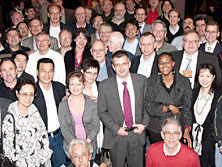Colour People Interview

Dr Andreas Kraushaar (39) is head of the prepress technology department at Forschungsgesellschaft Druck e.V. (FOGRA). FOGRA is a non-profit institution based in Munich that is primarily dedicated to standardisation and quality in printing processes. In addition to the "Process Standard Offset" (PSO), the FOGRA-ICC profiles are well-known in printing companies. Current is for example "FOGRA39", with which colour can be meaningfully converted into CMYK for offset printing on coated papers.
Dr Kraushaar joined FOGRA after studying media technology at the Technical University of Ilmenau. There he completed his doctorate at RWTH Aachen University in parallel. He has published numerous practical and scientific papers and has played a major role in the implementation of the Process Standard Digital (PSD). He already holds an influential position in the field of colour at a young age - and does so with the greatest enthusiasm.
Kraushaar comes from Eichsfeld and now lives in Munich.
Questions for Andreas Kraushaar
Mr Kraushaar, what is your favourite colour and what do you associate with it?
That's pretty mundane for me. My favourite colour is green. I had my first car painted Kawasaki green metallic. Today I'm almost ashamed of it, but it was the time, I found it very attractive and I still find it very beautiful. Today, for example, when I get to choose tokens, I choose green. This is also the colour of hope - I used to be an altar boy and loved to wear the green mass clothes.
How did you get into the subject of colour?
I studied media technology in Ilmenau and came to lighting technology by chance. There I got to know Professor Dietrich Gall and his lectures. What fascinated me was that as a colour-vision deficient person, he had a very special approach to colour. On the one hand, he was fascinated by colour, but he also wanted to understand and scientifically falsify the judgements of others. So he cleverly tried to question our statements and put hurdles in front of us. I found that very exciting and interesting. Professor Gall also separated the scientific and the harmonic nature of colour very nicely. Professor Gall, who is now retired but still very active, is the reason why I am so intensively involved with colour today.

What is your task today regarding colour?
I have a certain freedom of design in the research work of FOGRA's pre-press department. That is another reason why I feel very comfortable there. I don't just work through fixed programmes, but can set my own priorities and decide for myself where the journey takes me. It is my job to have a very good command of the practical use of colour in printing, so that in seminars, exams and symposia we can strike a balance with practical use. On the one hand we have to know the programmes well so that we know how to implement it well, and on the other hand we have to communicate the procedures well. My main task is to master the practical challenges in the field of colour management, screen measurement and modelling and to present them in simple terms for the target group.

Where is the journey heading?
When it comes to image quality, colour is still a very important aspect. Colour in 3D printing is also becoming an important issue. With colour and appearance, other aspects are added to the colour itself, such as texture, gloss, surface texture and viewing angle.

What are you working on at the moment?
I am currently working on the theme of the colour of teeth. This is not only very exciting, but also the most humbling subject I have experienced so far, because there you have the challenges of opalescence, transparency, translucency and fluorescence in addition to reflection. It is the supreme discipline, I am curious to see how the project will develop.
The subject of colour is always exciting and challenging, even if I "only" concentrate on the area of colourimetry, colour appearance, colour differences.
What fascinates you about the topic?
It is the interdisciplinarity. We have so many approaches and so many approaches to colour! Colour harmony, ophthalmology, colour physiology, colour physics.... You can work with colour as an engineer, physicist, designer, biologist or psychologist. I am always fascinated by the beauty of colour, and the simultaneous technical view: how can I reproduce colour as accurately as possible in one way or another, how metameric is it?
Thank you very much for this interview, Dr Kraushaar.
The questions were asked by Holger Everding.
Further information
...you will find under http://www.fogra.de
The questions were asked by Holger Everding.
Further information
...you will find under http://www.fogra.de.[:]
